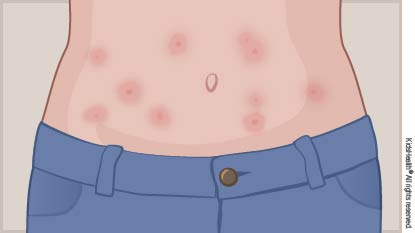Erythema Multiforme
What Is Erythema Multiforme?
Erythema multiforme is an allergic reaction. It causes a rash of spots with dark centers and pale red rings that look like a target or "bulls-eye." Some spots can have a small blister or scab in the middle.
What Are the Signs & Symptoms of Erythema Multiforme?
Erythema multiforme (air-uh-THEE-muh mul-teh-FOR-mee) starts with pink or red blotches. They grow over a few days into round spots that look like targets with red, pink, and pale rings.
Often, the rash starts on the arms, hands, legs, and feet, then appears on the face, neck, diaper area, and body.
The rash is most often on both sides of the body. It might not bother kids, but it can itch or burn.
When spots are also on the lips or mouth, it is called erythema multiforme major. These rashes should be checked by your doctor.

As the rash goes away, the skin where the spots were can look dark for a few months, but won't leave a scar.
The rash might be the only sign, but sometimes kids with erythema multiforme also:
- feel tired
- have a mild fever
- have sore muscles and joints
- have puffy hands or feet
What Causes Erythema Multiforme?
Most cases of erythema multiforme happen because the body has an allergic reaction to an infection or a medicine. The most common trigger is the virus that causes cold sores. In kids, a type of bacteria that cause lung infections also can trigger erythema multiforme.
Less often a medicine causes it. Some medicines that can cause a reaction are:
- penicillin or sulfa-based antibiotics
- some anti-seizure medicines
- anesthesia
- nonsteroidal anti-inflammatory drugs (NSAIDs), like ibuprofen
Is Erythema Multiforme Contagious?
No, the rash can't spread from person to person. If an infection causes it, that infection can spread. But someone else who gets the infection may not get the rash too.
How Is Erythema Multiforme Diagnosed?
Doctors know it's erythema multiforme by looking at it. To help figure out what caused it, the doctor will ask about any recent sickness the child had and any medicines he or she takes. Sometimes, the cause isn't known.
How Is Erythema Multiforme Treated?
Erythema multiforme goes away on its own. If the cause is an infection, the doctor may treat that. If a medicine was the cause, the doctor will stop it and use a new one if a medicine is still needed.
If your child has erythema multiforme caused by the cold sore virus, the rash might come back when cold sores come back. If it keeps coming back, the doctor may give a medicine to fight the cold sore virus to keep the rash away.
Doctors might treat some severe cases with steroid medicines.
How Can Parents Help?
To help make kids feel better, doctors may suggest:
- putting cool packs on the rash
- taking a cool bath or shower
- using acetaminophen (like Tylenol or a store brand) for pain or fever
- using antihistamines (like Benadryl, Claritin, Zyrtec, or store brands)
- putting creams on the skin to help with itchiness
These treatments won't make the rash go away faster, but will make a child feel better until the rash is gone.
When Should I Call the Doctor?
Call the doctor if you think your child has erythema multiforme. Other rashes due to more serious illness can look similar, so your doctor should check the rash.
If your child is diagnosed with erythema multiforme, call the doctor if your child has any of these problems:
- spots in the mouth or lips
- spots around the eyes or the white part of the eyes look red
- trouble drinking liquids
- pain that doesn't get better with pain medicine
- peeling skin
What Else Should I Know?
The erythema multiforme rash often goes away in 1 to 2 weeks, but can last as long as 4 weeks. It doesn't cause a scar, but in some kids might leave darker spots on the skin for a few months.
It can be hard to wait until the rash goes away. You can help your child by treating the itching and pain and calling the doctor if you think your child is getting worse.


